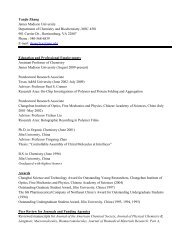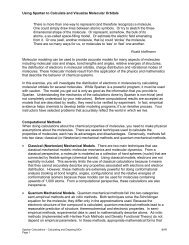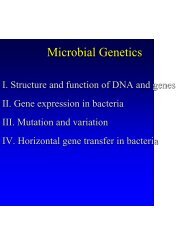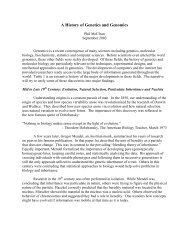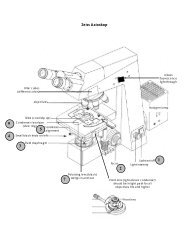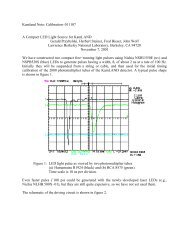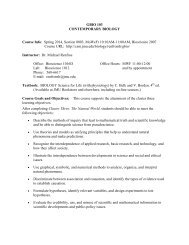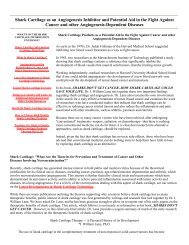Bacterial cytoplasm, endospores, motility & flagella Bacterial ...
Bacterial cytoplasm, endospores, motility & flagella Bacterial ...
Bacterial cytoplasm, endospores, motility & flagella Bacterial ...
Create successful ePaper yourself
Turn your PDF publications into a flip-book with our unique Google optimized e-Paper software.
<strong>Bacterial</strong> <strong>cytoplasm</strong>,<br />
<strong>endospores</strong>, <strong>motility</strong> & <strong>flagella</strong>
Within the <strong>cytoplasm</strong><br />
Genetic material<br />
➤Chromosome<br />
➤Plasmids<br />
Ribosomes<br />
Storage bodies and inclusions
Bacteria generally have a<br />
single large chromosome<br />
Genetic Material<br />
It is not bounded by a<br />
membrane<br />
Nucleoid
Plasmids<br />
Extrachromosomal circular DNA<br />
Plasmids in a bacterial host cell. A<br />
cell may contain no plasmids, , one<br />
plasmid or many copies of a<br />
plasmid. A single host may contain<br />
a number of different plasmids.<br />
• Contain genes which are not<br />
necessary for the organism’s<br />
survival but which may be useful to<br />
it (e.g antibiotic resistance genes,<br />
genes for enzymes which degrade<br />
pollutants for consumption by the<br />
cell, etc.).<br />
• Can be transferred ‘horizontally’<br />
(from mature cell to mature cell)<br />
http://www.wsu<br />
wsu.edu:8080/~<br />
:8080/~hurlbert/pages/Chap9.html#Plasmids
Plasmids (cont.)<br />
Used as vectors for transferring DNA in<br />
genetic engineering<br />
Electron micrograph of pCMVLuc<br />
plasmid DNA<br />
http://www.qiagen<br />
qiagen.com/catalog/Fig6_1.html
Ribosomes<br />
Used for constructing proteins from messenger<br />
RNA (mRNA)) (more on this later)<br />
In two parts and made up of proteins and ribosomal<br />
RNA (rRNA)
Storage bodies and inclusions: PHB,<br />
glycogen, sulfur, magnetosomes<br />
poly β-hydroxybutyrate<br />
(PHB) granules
Endospores<br />
• Formed for<br />
survival, not<br />
reproduction<br />
• Toughest,<br />
most resistant<br />
life form of all<br />
due to<br />
presence of<br />
dipicolinic<br />
acid in the<br />
spore coat
250 Million Year Old Bug Unearthed and Regrown<br />
by Dan Ferber<br />
Deep within salt crystals trapped for eons<br />
below a New Mexico desert, researchers<br />
found a 250-million-year-old strain of<br />
bacteria. The bacterium, reported at the<br />
annual American Society for Microbiology,<br />
is ten times older than the oldest known<br />
bacterium. The ancient strain could offer<br />
scientists new insights into the state of<br />
bacterial evolution from a time before the<br />
dinosaurs.<br />
The new strain was recovered from brine pockets in salt crystals known as chevrons, said<br />
microbiologist Russell Vreeland of West Chester University, West Chester, Pennsylvania.<br />
The crystals were found in a geological formation half a mile below the New Mexico desert,<br />
in tunnels dug more than 20 years ago to dispose of low-level radioactive waste, he said.
Endospores (cont.)<br />
Formed within cell (endo(<br />
= inside) unlike fungal spores
Endospore germination
Significance of Endospores<br />
Two major genera have them: Bacillus and<br />
Clostridium.<br />
➤Bacillus anthracis -- causal agent of anthrax<br />
➤Clostridium tetani -- causal agent of tetanus<br />
➤C. perfringens -- causal agent of gas gangrene<br />
➤C. botulinum -- causal agent of botulism<br />
Persistence and resistance of <strong>endospores</strong><br />
contribute to the pathogenicity of these<br />
species.
Peritrichous <strong>flagella</strong><br />
<strong>Bacterial</strong> Motility
Polar <strong>flagella</strong>
Run and tumble <strong>motility</strong>
Run and tumble <strong>motility</strong>
In the presence of an attractant, runs become longer and<br />
tumbles fewer, thus effectively propelling the cell toward<br />
the attractant. This phenomenon is known as chemotaxis.
The bacterial flagellum
Eukaryotic <strong>motility</strong> structures<br />
•Flagella<br />
and cilia are similar in composition but differ in size and function<br />
•Flagella found singly or in pairs at the<br />
end of some protozoa and algae<br />
•Larger than bacterial <strong>flagella</strong><br />
•Move in a whip-like manner rather<br />
than rotation of prokaryotic <strong>flagella</strong><br />
•Cilia only found in ciliates, , a type of<br />
protozoan.<br />
•Shorter, more numerous than <strong>flagella</strong> (of<br />
eukaryotes)<br />
•Function like oars: beat in synchrony to<br />
move cell (or to draw in food particles)
Eukaryotic Motility
Why don’t prokaryotes have<br />
membrane-bound organelles<br />
One answer: they may not need them
One reason for internal membranous<br />
structures in eukaryotes: surface/volume ratio<br />
A smaller cell has more efficient exchange with its surroundings because<br />
it has more membrane surface area for its volume
Thus, internal membranes may be needed for<br />
efficient transport (and<br />
compartmentalization) inside eukaryotic<br />
cells because their volume is great relative<br />
to their surface.<br />
In simpler words, more of the inside of a<br />
prokaryotic cell is closer to the surface<br />
(where exchange of nutrients and waste<br />
occurs) than is the case in eukaryotes. . Thus,<br />
membranous structures are needed for<br />
movement and storage.



